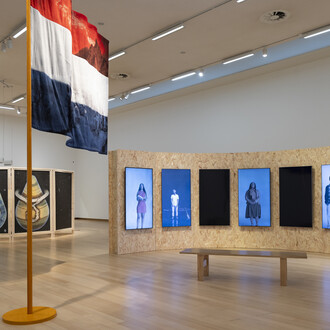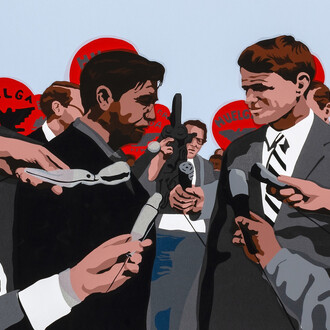YOU ARE SEEING THINGS is a video triptych by the Brazilian artist duo Bárbara Wagner & Benjamin De Burca. These three short, narrative works blend fiction and documentary into a form with echoes of the musical genre. Through music, dialogues and dance the artists evoke the complex interconnectedness in Brazilian popular culture.
This spring at the Stedelijk Museum the Brazilian artist duo Bárbara Wagner & Benjamin present YOU ARE SEEING THINGS, a triptych of their videos Faz Que vai / Set To Go (2015), Estás Vendo Coisas / You Are Seeing Things (2016) and Terremoto Santo / Holy Tremor (2017). These three short, narrative works blend fiction and documentary into a form with echoes of the musical genre. Through music, dialogues and dance the artists evoke the complex interconnectedness in Brazilian popular culture of class, gender, race, religion and the economy.
On display at the Stedelijk for the first time in this interrelated form, they bear witness to the powerful do-it-yourself culture in Northeast Brazil that is helping to shape a new collective identity through new music and dance cultures, and emergent religious movements. Part scripted, part documentary, these musical film collages with a non-linear narrative structure are as hybrid as the communities they portray. Notably, this artist duo has been selected to represent Brazil at this year’s Venice Biennale.
More than half the population of Northeast Brazil is of partly African heritage, and the region’s music and dance culture is rooted in rebellion against colonialism and slavery. Wagner & de Burca’s videos show how the local young people appropriate these expressive forms to respond to officially sanctioned culture and the commercial mainstream. Faz Que Vai, for example, centers around Frevo, a Capoeira-style dance involving small umbrellas, which originated in Pernambuco state: while the tourist industry promotes Frevo as traditional heritage, the transgender community has transformed it into a subversive and self-assertive Vogueing style. In Estás Vendo Coisas we see how the traditional and contemporary Brega music subculture, with its origins in local communities, is cutting its own unique path to a wider audience by organizing parties and posting self-produced music videos on social media. And Terremoto Santo shows how the tumultuous rise of the Protestant evangelical church in Brazil is offering young people an unexpected opportunity to build a financially stable existence for themselves through gospel music.
















